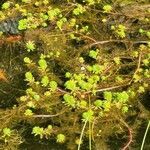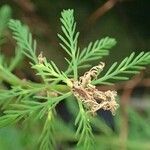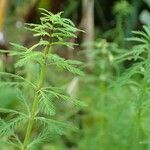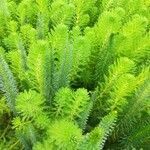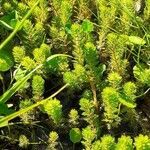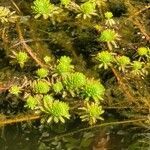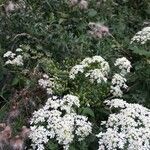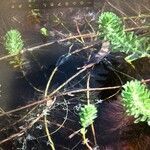Aquatic or semiterrestrial. Stem branched mostly at the base only, perpetuating growth after anthesis. Lower immersed leaves pinnate, segments thread-like. Upper immersed leaves and aerial leaves alternately in whorls of 5 (rarely 4), flanked by 2-3 c. 1 mm long, mostly recurved enatia, hydrophobic and often ± glaucous. Leaf-base ± dilated, c. 0.6-1 mm wide, of a whorl at least in the upper sterile shoots enclosing the stem at the nodes, blade oblong in outline, c. 2-4 by ½-1 cm, rather stiffly patent to erectopatent, with 8-18 pairs of subulate, mucronate lobes, 2-8 by c. 0.2 mm. Mostly monoecious or ± dioecious, sometimes in the middle with ☿ flowers. Flowers solitary in the middle and upper leaf-axils. ♂ Flowers (not seen in Mal.): pedicel up to 4 by 0.4 mm, up-and downwards broadened. Bracteoles subulate, 2-3 mm long, ± flat, often with 1 or 2 lateral laciniae. Sepals narrowly triangular, acute, serrate towards the apex, c. 1½-2 by ½ nam, at first erect, finally recurved. Petals 4, caducous before anthesis, c. 4 mm long. Stamens 8; anthers linear-lanceolate, c. 4 by 1 mm. Ovary reduced, up to 0.3 mm long ♀ Flowers: pedicel up to 1 by 0.4 mm, cylindric, erect. Bracteoles subulate with dilated base, sometimes with 1 lacinia, 1-1½ nun long. Sepals narrowly triangular, acute, entire or scarcely serrate, 1-1½ by 0.2-0.3 mm, at first erect, finally recurved. Petals very strongly reduced, subulate, adnate to the torus, up to ½ mm long. Styles 0.2-0.3 mm. Fruit (sec. SCHINDLER) ovoid, 4-sulcate, c. 1.8 by 1.2 mm, shortly pedicelled, papillose.
Aquatic herb, usually submerged, with the upper part floating at the surface or sometimes creeping on to sandy or muddy banks; rhizome rooted; stems up to 1.2 m long, simple or sparsely branched at the base. Leaves all pinnatisect, in alternating whorls of (4)5-6, densely papillose (when dry simulating puberulence), usually much longer than internodes, their bases flanked by 2-3 linear, mostly recurved, deciduous stipule-like outgrowths; leaf-segments 8-16(30) on each side, linear-subulate, with a mucronulate apex; leaf-base dilated, almost concealing the stem at least at upper nodes. Flowers unisexual, solitary in the middle and upper leaf-axils; bracteoles subulate, with 1-2 lateral laciniae in male, laterally 1-2-dentate in female. Petals 4, c. 4 mm long, absent in female. Stamens usually 8, rarely less; anthers c. 3 mm long; filaments up to 5 mm long. Stigmas 4, shortly papillose. Fruit c. 1.8 x 1.2 mm, ovoid, longitudinally 4-sulcate, papillose-punctate.
Stout, glabrous, dioecious herb. Stems to 2 m long, 4-5 mm diam. near base, glaucous, rooting from lower nodes. Lvs all whorled, slightly dimorphic. Submerged lvs in whorls of (4)-5-6, (17)-35-45 × (4)-8-15 mm, oblanceolate or oblong with rounded apex, pectinate; pinnae 25-30, to 7 mm long, linear-subulate. Aerial lvs in whorls of (4)-5-6, (15)-25-35 × (4)-7-8 mm, narrowly oblanceolate or oblong with rounded apex, pectinate, glaucous, ± erect near apex; pinnae (18)-24-36, to 5.5 mm long, linear-subulate, slightly incurved. Base of aerial lvs with numerous hydathodes. Fls solitary in the axils of upper aerial lvs which are almost identical to other aerial lvs. Bracteoles 1.2-1.5 mm long, subulate, sometimes almost 3-fid. ♂ fls not seen in N.Z. ♀ fls with pedicel c. 0.2-0.4 mm long; sepals 0.4-0.5 × 0.3 mm, deltoid, white, denticulate with 1-several teeth; petals 0; ovary 4-ribbed between sepals. Fr. not seen.
Stout aquatic or marsh herb, dioecious (only with female flowers in Australia). Stems to 2 m long, glaucous. Leaves in whorls of 4–6, pectinate; submerged leaves oblanceolate, to 4 cm long; emergent leaves narrowly oblanceolate, glaucous, lamina to 3.5 cm long. Bracteoles subulate to trifid, 1.2–1.5 mm long, white. Female flowers 4-merous, shortly pedicellate, solitary; sepals deltoid, 0.4–0.5 mm long, white; petals absent; ovary 4-locular; styles clavate, 0.1–0.2 mm long; stigmas white. Fruit not formed.
A plant which keeps growing from year to year. It grows partly under water. It forms masses of leafy tangled stems. It has stolons or runners and these form roots on the lower nodes. The leaves are in rings of 4-6 from the same level of the stems. The leaves are feathery in appearance. They are pale green. The leaves under the water rot leaving bare stems. Plants are separately male and female. Only female plants are recorded in Australia. Flowers form in the axils of leaves. They occur singly.
Perennial herb, hydrophyte, rooted, emerging 0.2-0.5 m above water surface. Roots arising from nodes of stems, many, long. Leaves arranged in whorls of 4-6, pale green, finely divided, feather-like, pectinate-pinnate. Flowers unisexual or bisexual, axillary, solitary, cream-coloured, sessile or shortly pedicelled, or in a terminal spike with male flowers above and female below; bracts leafy; bracteoles 2, concave. Flowering time May-Dec. Fruit none, vegetative propagation.
Stems stout, very leafy; lvs all whorled, 2–5 cm, with 10–18 segments on each side, the lower segments much reduced, the rachis to 1 mm wide; petioles 5–7 mm; fls axillary to scarcely modified lvs in emergent infls; fr 1.5–2 mm, minutely granular; pls dioecious, only the pistillate, white fls known in N. Amer. Native of S. Amer., commonly cult. in aquaria and often escaped in s. U.S., n. to N.Y., W.Va., and Mo. (M. brasiliense)
Hydrophyte, usually submerged with upper part floating at surface. Leaf segments linear, leaf bases accompanied by deciduous stipule-like outgrowths, mostly recurved, apex mucronulate, densely glandular, glands sessile, minute. Flowers: solitary in median and upper leaf axils of stems, usually floating at surface; corolla cream-coloured; May-Sep. Fruits none, propagation occurs vegetatively.
Leaves all pinnatisect, in alternating whorls of (4)5–6, densely papillose (when dry simulating puberulence), usually much longer than internodes, their bases flanked by 2–3 linear, mostly recurved, deciduous stipule-like outgrowths; leaf-segments 8–16(30) on each side, linear-subulate, with a mucronulate apex; leaf-base dilated, almost concealing the stem at least at upper nodes.
Aquatic herb, usually submerged, with the upper part floating at the surface or sometimes creeping on to sandy or muddy banks; rhizome rooted; stems up to 1·2 m. long, simple or sparsely branched at the base.
Flowers unisexual, solitary in the middle and upper leaf-axils; bracteoles subulate, with 1–2 lateral laciniae in male, laterally 1–2-dentate in female.
Like M. spicatum but leaves emergent, densely papillose with deciduous, awl-shaped, stipule-like outgrowths and flowers solitary in axils.
Stamens usually 8, rarely less; anthers c. 3 mm. long; filaments up to 5 mm. long.
Fruit c. 1·8 x 1·2 mm., ovoid, longitudinally 4-sulcate, papillose-punctate.
Petals 4, c. 4 mm. long, absent in female.
Stigmas 4, shortly papillose.
